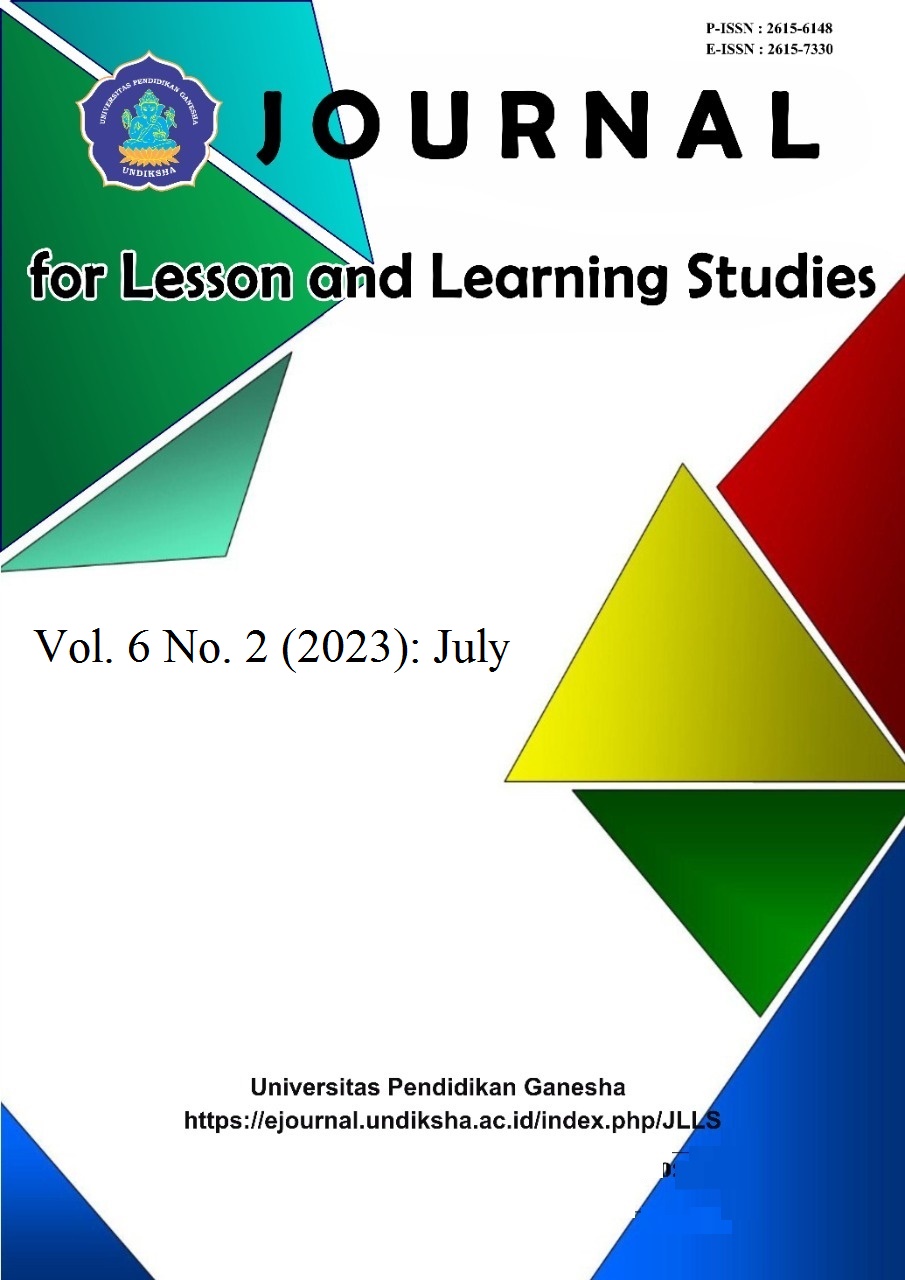PENGEMBANGAN MEDIA FLASHCARD BERBASIS AUGMENTED REALITY PADA MATERI BANGUN RUANG UNTUK MENINGKATKAN HASIL BELAJAR KOGNITIF SISWA KELAS V SEKOLAH DASAR
DOI:
https://doi.org/10.23887/jlls.v6i2.64126Kata Kunci:
pengembangan media, flashcard, augmented realityAbstrak
Pendidikan di Indonesia memasuki era baru, yang ditunjukkan dengan adanya pembaharuan sebagai bentuk usaha pengembangan dalam mencapai perbaikan untuk kualitas yang lebih baik lagi. Pembaharuan menimbulkan tantangan-tantangan baru dalam era society 5.0 dalam bidang pendidikan. Berdasarkan wawancara yang dilakukan terdapat kendala diantaranya siswa kurang memahami konsep, bentuk beserta rumus bangun ruang sehingga proses pembelajaran tidak berjalan dengan baik dan hasil belajar kognitif siswa tidak maksimal. dengan tujuan untuk menghasilkan produk media flashcard berbasis augmented reality sebagai media yang valid, praktis dan efektif untuk meningkatkan hasil belajar kognitif siswa kelas V Sekolah Dasar.Pengembangan media flashcard berbasis augmented relality menggunakan model ADDIE kemudian hasil dari pengembangan media diukur melalui 3 kriteria yaitu valid, praktis dan efektif. Berdasarkan hasil validasi ahli materi memperoleh persentase 79,2% masuk dalam kriteria valid. Kriteria kedua yaitu praktis melalui angket guru dan siswa uji coba kelompok kecil memperoleh persentase 88,7% masuk dalam kriteria sangat praktis dan angket siswa memperoleh persentase 89,5% masuk dalam kriteria sangat praktis. Angket guru dan siswa pada saat uji coba kelompok besar untuk guru memperoleh persentase 91,2 % masuk dalam kriteria sangat praktis dan untuk siswa memperoleh persentase 88,3 % masuk dalam kriteria sangat praktis. Kriteria yang ketiga yaitu efektif. Berdasarkan uji hipotesis diketahui bahwa ada perbedaan sebelum dan sesudah menggunakan media.
Referensi
Adrian, Q. J., Ambarwari, A., & Lubis, M. (2020). Perancangan Buku Elektronik Pada Pelajaran Matematika Bangun Ruang Sekolah Dasar Berbasis Augmented Reality. Simetris: Jurnal Teknik Mesin, Elektro Dan Ilmu Komputer, 11(1), 171–176. https://doi.org/10.24176/simet.v11i1.3842.
Afifah, S. N., & Kusuma, A. B. (2021). Pentingnya Kemampuan Self-Efficacy Matematis Serta Berpikir Kritis Pada Pembelajaran Daring Matematika. Jurnal MathEdu (Mathematic Education Journal), 4(2), 313–320. https://doi.org/10.37081/mathedu.v4i2.2642.
Al-Maroof, R. A. S., & Al-Emran, M. (2018). Students acceptance of google classroom: An exploratory study using PLS-SEM approach. International Journal of Emerging Technologies in Learning, 13(6), 112–123. https://doi.org/10.3991/ijet.v13i06.8275.
Antara, I. G. W. S., & Dewantara, K. A. K. (2022). E-Scrapbook: The Needs of HOTS Oriented Digital Learning Media in Elementary Schools. Journal for Lesson and Learning Studies, 5(1), 71–76. https://doi.org/10.23887/jlls.v5i1.48533.
Arianti, N. M., Wiarta, I. W., & Darsana, I. W. (2019). Pengaruh Model Pembelajaran Problem Posing Berbantuan Media Semi Konkret terhadap Kompetensi Pengetahuan Matematika. Jurnal Ilmiah Sekolah Dasar, 3(4), 394. https://doi.org/10.23887/jisd.v3i4.21765.
Arnandi, F., Siregar, N., & Fitriawan, D. (2022). Media Pembelajaran Matematika Menggunakan Smart Apps Creator pada Materi Bilangan Bulat di Sekolah Dasar. Plusminus: Jurnal Pendidikan Matematika, 2(3). https://doi.org/10.31980/plusminus.v2i3.2194.
Azima, S., Furnamasari, N., Furi, Y., & Anggraeni, D. (2021). Pengaruh Masuknya Budaya Asing Terhadap Nasionalisme Bangsa Indonesia di Era Globalisasi. Jurnal Pendidikan Tambusai, 5(3), 7491–7496. https://jptam.org/index.php/jptam/article/view/2186.
Bistaman, I. N. M., Idrus, S. Z. S., & Rashid, S. A. (2018). The Use of Augmented Reality Technology for Primary School Education in Perlis, Malaysia. Journal of Physics: Conference Series, 1019(1). https://doi.org/10.1088/1742-6596/1019/1/012064.
Dewi, P. D. P., & Suniasih, W. (2022). Media Video Pembelajaran Matematika Berbasis Etnomatematika pada Muatan Materi Pengenalan Bangun Datar. Jurnal Edutech Undiksha, 10(1), 156–166. https://doi.org/10.23887/jeu.v10i1.44775.
Erviana, T. (2019). Kemampuan Penalaran Matematis Siswa Dalam Memecahkan Masalah Aljabar Berdasarkan Gaya Kognitif Field Independent. Alifmatika: Jurnal Pendidikan Dan Pembelajaran Matematika, 1(1), 61–73. https://doi.org/10.35316/alifmatika.2019.v1i1.61-73.
Gandana, G., & Fauziah, D. E. (2023). Analisis Penggunaan Flashcard Berbasis Digital untuk Meningkatkan Kemampuan Bahasa Reseptif Anak Usia Dini. Jurnal Program Studi Pendidikan Anak Usia Dini, 12(1). https://doi.org/10.31000/ceria.v12i1.9023.
Handayani, N. P. R., & Abadi, I. B. G. S. (2020). Pengaruh Model Pembelajaran Langsung Berbantuan Media Gambar Terhadap Kompetensi Pengetahuan Matematika Siswa Kelas IV SD. Mimbar Ilmu, 25(1), 120. https://doi.org/10.23887/mi.v25i1.24767.
Huang, K. T., Ball, C., Francis, J., Ratan, R., Boumis, J., & Fordham, J. (2019). Augmented versus virtual reality in education: An exploratory study examining science knowledge retention when using augmented reality/virtual reality mobile applications. Cyberpsychology, Behavior, and Social Networking, 22(2), 105–110. https://doi.org/10.1089/cyber.2018.0150.
Indariani, A., Amami Pramuditya, S., & Firmasari, S. (2018). Pengembangan Bahan Ajar Digital Berbasis Kemampuan Pemecahan Masalah Matematis Pada Pembelajaran Matematika (Bahan Ajar Digital Interaktif pada Materi Pertidaksamaan Nilai Mutlak Linear Satu Variabel). Eduma : Mathematics Education Learning and Teaching, 7(2), 89–98. https://doi.org/10.24235/eduma.v7i2.3670.
Irawati, A. E., & Setyadi, D. (2021). Pengembangan E-Modul Matematika pada Materi Perbandingan Berbasis Android. Jurnal Cendekia : Jurnal Pendidikan Matematika, 5(3), 3148–3159. https://doi.org/10.31004/cendekia.v5i3.467.
Komariah, S., Suhendri, H., & Hakim, A. R. (2018). Pengembangan Media Pembelajaran Matematika Siswa SMP Berbasis Android. JKPM (Jurnal Kajian Pendidikan Matematika), 4(1), 43. https://doi.org/10.30998/jkpm.v4i1.2805.
Lubis, A. H., & Dasopang, M. D. (2020). Pengembangan Buku Cerita Bergambar Berbasis Augmented Reality untuk Mengakomodasi Generasi Z. Jurnal Pendidikan: Teori, Penelitian, Dan Pengembangan, 5(6), 780. https://doi.org/10.17977/jptpp.v5i6.13613.
Munthe, A. P., & Sitinjak, J. V. (2019). Manfaat Serta Kendala Menerapkan Flashcard Pada Pelajaran Membaca Permulaan. Jurnal Dinamika Pendidikan, 11(3), 210. https://doi.org/10.33541/jdp.v11i3.892.
Nirwanto, B. G., Murtono, M., & Fathurrohman, I. (2021). Media Puzzle Berbantu Augmented Reality pada Muatan Pelajaran IPA Tema Ekosistem. Jurnal Edutech Undiksha, 9(2), 275. https://doi.org/10.23887/jeu.v9i2.38503.
Nugraha, N. B. (2022). Game Edukasi Interaktif Pengenalan Tata Surya Berbasis Animasi 2D untuk Siswa Kelas 6 SD. Pixel :Jurnal Ilmiah Komputer Grafis, 15(1), 113–120. https://doi.org/10.51903/pixel.v15i1.741.
Octavyanti, N. P. L., & Wulandari, I. G. A. A. (2021). Pengembangan Video Pembelajaran Berbasis Pendekatan Kontekstual Pada Mata Pelajaran Matematika Kelas IV SD. Jurnal Edutech Undiksha, 9(1). https://doi.org/10.23887/jeu.v9i1.32223.
Pradana, P. H., & Gerhni, F. (2019). Penerapan Media Pembelajaran Flash Card untuk Meningkatkan Perkembangan Bahasa Anak. Journal of Education and Instruction (JOEAI), 2(1), 25–31. https://doi.org/10.31539/joeai.v2i1.587.
Rizaldi, D. R., Nurhayati, E., & Fatimah, Z. (2020). The Correlation of Digital Literation and STEM Integration to Improve Indonesian Students’ Skills in 21st Century. International Journal of Asian Education, 1(2), 73–80. https://doi.org/10.46966/ijae.v1i2.36.
Rofiqoh, I., Puspitasari, D., & Nursaidah, Z. (2020). Pengembangan game math space adventure sebagai media pembelajaran pada materi pecahan di sekolah dasar. Lentera Sriwijaya: Jurnal Ilmiah Pendidikan Matematika, 2(1), 41–54. https://ejournal.unsri.ac.id/index.php/lenterasriwijaya/article/view/11445.
Sintaro, S., Surahman, A., & Khairandi, N. (2020). Aplikasi Pembelajaran Teknik Dasar Futsal Menggunakan Augmented Reality Berbasis Android. Telefortech : Journal of Telematics and Information Technology, 1(1). https://doi.org/10.33365/tft.v1i1.860.
Umam, K. (2018). Peningkatan Kemampuan Berpikir Kritis Matematis Siswa Melalui Pembelajaran Reciprocal Teaching. JPMI (Jurnal Pendidikan Matematika Indonesia), 3(2), 57. https://doi.org/10.26737/jpmi.v3i2.807.
Wibowo, V. R., Putri, K. E., & Mukmin, B. A. (2022). Pengembangan Media Pembelajaran Berbasis Augmented Reality pada Materi Penggolongan Hewan Kelas V Sekolah Dasar. Jurnal Tindakan Kelas, 3(1), 58–69. https://doi.org/10.53624/ptk.v3il.119.
Widiarti, N. K., Sudarma, I. K., & Tegeh, I. M. (2021). Meningkatkan Hasil Belajar Matematika Kelas V SD Melalui Media Video Pembelajaran. Jurnal Edutech Undiksha, 9(2), 195. https://doi.org/10.23887/jeu.v9i2.38376.
Winangun, I. M. A. (2020). Pengenalan Life Science Bagi Anak Usia Dini Melalui Media Flashcard Berkonten Lokal. Widya Kumara: Jurnal Pendidikan Anak Usia Dini, 1(2), 80–89. https://doi.org/10.55115/widyakumara.v1i2.934.
Wiweka, I. N. A., Mahadewi, L. P. P., & Suwatra, I. I. W. (2021). Meningkatkan Hasil Belajar Bahasa Bali Siswa Melalui Multimedia Flashcard Bilingual. Jurnal Edutech Undiksha, 8(1), 95–103. https://doi.org/10.23887/jeu.v9i1.32074.
Wuyung, O. D., & Widiastuti, K. (2020). Implementasi Model Pembelajaran Kooperatif Tipe Team Games Tournament (TGT) Berbantu Media Pembelajaran Permainan Tradisional Cublak-Cublak Suweng Untuk Meningkatkan Motivasi Belajar Dalam Pembelajaran Matematika Siswa Kelas IV SD Bina Tunas. Widya Accarya, 11(2), 188–197. https://doi.org/10.46650/wa.11.2.946.188-197.
Yip, J., Wong, S.-H., Yick, K.-L., Chan, K., & Wong, K.-H. (2019). Improving quality of teaching and learning in classes by using augmented reality video. Computers & Education, 128(1), 88–101. https://doi.org/10.1016/j.compedu.2018.09.014.
Unduhan
Diterbitkan
Cara Mengutip
Terbitan
Bagian
Lisensi
Hak Cipta (c) 2023 dian ratna sari, erry hidayanto, aynin mashfufah

Artikel ini berlisensiCreative Commons Attribution-ShareAlike 4.0 International License.
Authors who publish with the Journal for Lesson and Learning Studies agree to the following terms:
- Authors retain copyright and grant the journal the right of first publication with the work simultaneously licensed under a Creative Commons Attribution License (CC BY-SA 4.0) that allows others to share the work with an acknowledgment of the work's authorship and initial publication in this journal.
- Authors are able to enter into separate, additional contractual arrangements for the non-exclusive distribution of the journal's published version of the work (e.g., post it to an institutional repository or publish it in a book), with an acknowledgment of its initial publication in this journal.
- Authors are permitted and encouraged to post their work online (e.g., in institutional repositories or on their website) prior to and during the submission process, as it can lead to productive exchanges, as well as earlier and greater citation of published work. (See The Effect of Open Access)




